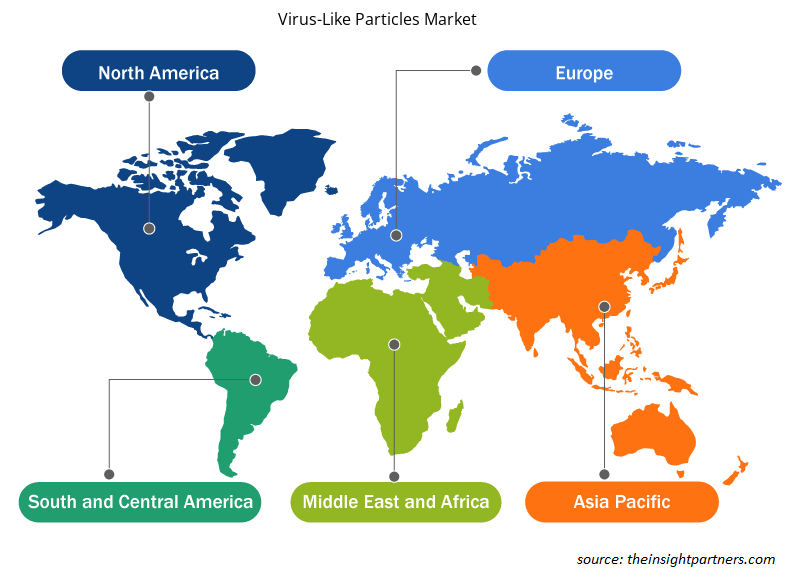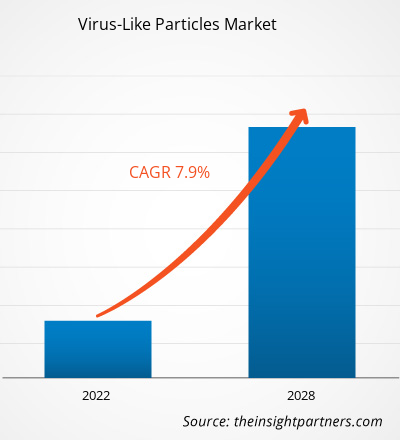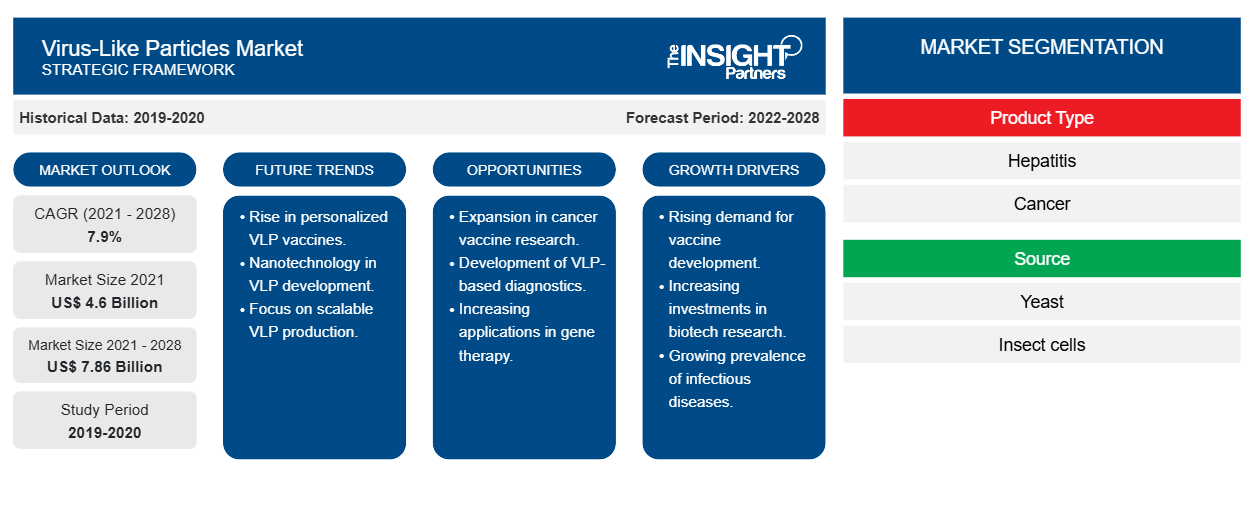Se proyecta que el mercado de partículas similares a virus (VLP) alcance los US$ 7.858,82 millones para 2028 desde los US$ 4.601,84 millones en 2021; se espera que crezca a una CAGR del 7,9% entre 2021 y 2028. VLP’s) market is projected to reach US$ 7,858.82 million by 2028 from US$ 4,601.84 million in 2021; it is expected to grow at a CAGR of 7.9% from 2021 to 2028.
La comercialización de vacunas basadas en partículas similares a virus contra virus humanos y animales, las intensas actividades de investigación y desarrollo para el desarrollo de vacunas virales basadas en partículas similares a virus y el surgimiento de partículas similares a virus como una plataforma de inmunoterapia confiable para enfermedades alérgicas son los factores impulsores clave responsables del crecimiento general del mercado. Sin embargo, los desafíos técnicos relacionados con el diseño, la purificación y el almacenamiento de eVLP impiden el crecimiento general del mercado. Además, las complejidades asociadas con la fabricación de vacunas de partículas similares a virus, junto con el exceso de costo y el requisito de tiempo de los procesos (como el procesamiento posterior para vacunas basadas en partículas similares a virus), limitan aún más el crecimiento del mercado global. Además, las terapias basadas en partículas similares a virus destinadas a enfermedades virales tópicas y emergentes, así como el cáncer, aún están en desarrollo, lo que plantea oportunidades lucrativas para el crecimiento general del mercado.
Es probable que América del Norte continúe dominando el mercado de partículas similares a virus durante el período 2021-2028. Estados Unidos tiene la mayor participación del mercado en América del Norte y se espera que continúe con esta tendencia durante el período de pronóstico. Esto se atribuye principalmente a la susceptibilidad comúnmente observada de las personas a las infecciones virales, como la influenza viral causada por diferentes variantes. Además, las continuas actividades de I+D necesarias para la fabricación de vacunas vivas atenuadas obligan a las empresas biofarmacéuticas a optar por partículas similares a virus, lo que respalda aún más el crecimiento del mercado.
Personalice este informe según sus necesidades
Obtendrá personalización en cualquier informe, sin cargo, incluidas partes de este informe o análisis a nivel de país, paquete de datos de Excel, así como también grandes ofertas y descuentos para empresas emergentes y universidades.
-
Obtenga las principales tendencias clave del mercado de este informe.Esta muestra GRATUITA incluirá análisis de datos, desde tendencias del mercado hasta estimaciones y pronósticos.
Perspectivas del mercado
Las vacunas comercializadas basadas en partículas similares a virus impulsan el crecimiento general del mercado
Según un informe publicado por Frontiers Media SA, la primera vacuna basada en partículas similares a virus fue diseñada para combatir un virus mortal, la hepatitis B , y las vacunas basadas en partículas similares a virus han producido resultados de seguridad prometedores en comparación con las vacunas tradicionales. La primera vacuna basada en partículas similares a virus comercializada fue contra el VHB. Además, las vacunas comerciales contra el VHB, a saber, "Engerix" fabricada por GlaxoSmithKline y "Recombivax HB" fabricada por Merck & Co. fueron aprobadas en 1980, y todas eran partículas similares a virus. La siguiente vacuna basada en partículas similares a virus disponible comercialmente fue "Gardasil", que fue aprobada en 2006 para prevenir las infecciones por el virus del papiloma humano (VPH). Además, las partículas similares a virus también se utilizan en medicina veterinaria. La primera vacuna veterinaria disponible comercialmente basada en partículas similares a virus demostró ser eficaz contra el circovirus porcino tipo 2 (PCV2).S.A., the first virus-like particles -based vaccine was designed to combat a deadly virus, HBV. Also, the commercial anti-HBV vaccines, namely, "Engerix" manufactured by GlaxoSmithKline and "Recombivax HB" manufactured by Merck & Co. were approved in 1980, and they were all virus-like particles. The next commercially available virus-like particles -based vaccine was "Gardasil," which was approved in 2006 to prevent human papillomavirus (HPV) infections. Further, virus-like particles are also used in veterinary medicine. The first commercially available veterinary vaccine based on virus-like particles was proven effective against porcine circovirus type 2 (PCV2).
El papel de las partículas similares a virus en el desarrollo de productos de inmunoterapia contra enfermedades alérgicas estimula aún más el crecimiento general del mercado. Las partículas similares a virus se utilizan en el tratamiento de la rinitis alérgica, el asma y las reacciones a los ácaros del polvo. Los factores antes mencionados impulsan el crecimiento del mercado general de partículas similares a virus de manera exponencial. Las vacunas con partículas similares a virus han demostrado una respuesta inmunitaria rápida con reacciones cutáneas leves como efectos secundarios.immunotherapy products against allergic diseases further stimulates the overall market growth. virus-like particles are used in the treatment of allergic rhinitis, asthma, and dust mite reactions. The aforementioned factors drive the growth of the overall virus-like particles market exponentially. virus-like particles vaccines have shown rapid immune response with mild skin reaction as side effects.
Información basada en el tipo de producto
Según el tipo de producto, el mercado de partículas similares a virus se segmenta en hepatitis, cáncer/VPH y enfermedad de Gaucher. El segmento de hepatitis representaría una gran participación de mercado durante 2021-2028. El informe de Frontiers SA señala que el virus de la hepatitis C (VHC) infecta al 2% de la población mundial y es una de las principales causas de enfermedad hepática y trasplante de hígado. Esta amenaza médica se puede abordar parcialmente mediante la introducción de nuevas terapias antivirales . Por ejemplo, una vacuna con una eficacia del 50 al 80%, dirigida a los usuarios de drogas intravenosas de alto riesgo, reduce drásticamente la incidencia del VHC entre la población. Por lo tanto, las partículas similares a virus representan una plataforma de administración de vacunas segura y altamente inmunogénica que induce una respuesta inmunitaria adaptativa. Varias vacunas basadas en partículas similares a virus se encuentran actualmente en ensayos clínicos; sin embargo, las vacunas VLP autorizadas para el VHB y el VPH se han utilizado desde hace mucho tiempo. Por lo tanto, las vacunas basadas en partículas similares a virus han demostrado su eficacia en relación con las características inmunológicas favorables y las convierten en una de las vacunas prometedoras contra el VHC.S.A. report pinpoints that hepatitis C virus (HCV) infects 2% of the global population, and it is a leading cause of liver disease and liver transplantation. This medical threat can partially be addressed by the introduction of new HCV incidence among the population. Therefore, virus-like particles represent a safe and highly immunogenic vaccine delivery platform that induces an adaptive immune response. Several virus-like particles -based vaccines are currently in clinical trials; however, licensed VLP vaccines for HBV and HPV have been in use since long. Thus, virus-like particles based vaccines have proved their effectiveness relating to favorable immunological characteristics and making them one of the promising HCV vaccines.
Perspectivas basadas en fuentes
Según la fuente, el mercado de partículas similares a virus (VLP) se segmenta en levaduras, células de insectos, plantas y otras. El segmento de levaduras tiene una participación de mercado considerable y se proyecta que continúe la tendencia similar durante el período de pronóstico. Las partículas similares a virus se producen mediante sistemas de expresión heterólogos, que involucran levaduras o baculovirus, así como plantas y bacterias. La seguridad de las vacunas basadas en partículas similares a virus producidas mediante sistemas de expresión de levaduras contribuye al crecimiento del mercado de partículas similares a virus basadas en levaduras.VLP’s) market is segmented into yeast, insect cell, plant, and others. The yeast segment holds a considerable market share and is projected to continue the similar trend during the forecast period. virus-like particles are produced by heterologous expression systems, involving yeast or baculovirus, as well as plants and bacteria. Safety of virus-like particles -based vaccines produced using yeast expression systems contributes to the growth of the market for the yeast-based virus-like particles.
Perspectivas basadas en aplicaciones
Por aplicación, el mercado de partículas similares a virus se segmenta en vacunas y terapias. El segmento de vacunas tendría una participación considerable del mercado en 2021, y es probable que continúe su dominio en el mercado también durante el período de pronóstico. La vacunación se considera una de las formas más efectivas de controlar patógenos y prevenir enfermedades, tanto en humanos como en animales. Las vacunas basadas en partículas similares a virus representan uno de los enfoques más atractivos debido a sus propiedades inmunogénicas intrínsecas y seguridad. Por ejemplo, las partículas similares a virus son antígenos multiméricos no infecciosos que tienen una estructura particulada, adecuada para la inducción de una respuesta inmune humoral y celular segura y eficiente. Aparte de eso, las vacunas de partículas similares a virus han demostrado su eficacia en el campo veterinario. Las partículas similares a virus solo están compuestas por una o más proteínas estructurales sin presencia de genomas de virus nativos y sin capacidad de autorreplicación en células. Sin embargo, se pueden producir partículas similares a virus que contengan antígenos monovalentes o multivalentes de conformidad con el requisito de vigilancia serológica; la utilidad de las vacunas de partículas similares a virus resulta prometedora en el campo veterinario. Un ejemplo de ello es el uso de vacunas de partículas similares a virus en las estrategias de vacunación para diferenciar animales infectados de vacunados (DIVA) contra enfermedades animales.
Las empresas que operan en el mercado de partículas similares a virus (VLP) adoptan la estrategia de innovación de productos para satisfacer las cambiantes demandas de los clientes en todo el mundo, lo que también les permite mantener su marca en el mercado global.
Alcance del informe de mercado sobre partículas similares a virus
Perspectivas regionales del mercado de partículas similares a virus
Los analistas de Insight Partners explicaron en detalle las tendencias y los factores regionales que influyen en el mercado de partículas similares a virus durante el período de pronóstico. Esta sección también analiza los segmentos y la geografía del mercado de partículas similares a virus en América del Norte, Europa, Asia Pacífico, Oriente Medio y África, y América del Sur y Central.

- Obtenga datos regionales específicos para el mercado de partículas similares a virus
Alcance del informe de mercado sobre partículas similares a virus
| Atributo del informe | Detalles |
|---|---|
| Tamaño del mercado en 2021 | 4.600 millones de dólares estadounidenses |
| Tamaño del mercado en 2028 | 7.860 millones de dólares estadounidenses |
| CAGR global (2021-2028) | 7,9% |
| Datos históricos | 2019-2020 |
| Período de pronóstico | 2022-2028 |
| Segmentos cubiertos |
Por tipo de producto
|
| Regiones y países cubiertos |
América del norte
|
| Líderes del mercado y perfiles de empresas clave |
|
Densidad de actores del mercado: comprensión de su impacto en la dinámica empresarial
El mercado de partículas similares a virus está creciendo rápidamente, impulsado por la creciente demanda de los usuarios finales debido a factores como la evolución de las preferencias de los consumidores, los avances tecnológicos y una mayor conciencia de los beneficios del producto. A medida que aumenta la demanda, las empresas amplían sus ofertas, innovan para satisfacer las necesidades de los consumidores y aprovechan las tendencias emergentes, lo que impulsa aún más el crecimiento del mercado.
La densidad de actores del mercado se refiere a la distribución de las empresas o firmas que operan dentro de un mercado o industria en particular. Indica cuántos competidores (actores del mercado) están presentes en un espacio de mercado determinado en relación con su tamaño o valor total de mercado.
Las principales empresas que operan en el mercado de partículas similares a virus son:
- Compañía farmacéutica Merck & Co., Inc.
- Compañía: GlaxoSmithKline plc.
- Pfizer Inc.
- Tecnologías Dynavax
- Sanofi
Descargo de responsabilidad : Las empresas enumeradas anteriormente no están clasificadas en ningún orden particular.

- Obtenga una descripción general de los principales actores clave del mercado de partículas similares a virus
Mercado de partículas similares a virus (VLP): por tipo de producto
- Hepatitis
- Cáncer/VPH
- Enfermedad de Gaucher
Mercado de partículas similares a virus (VLP) por origen
- Levadura
- Célula de insecto
- Planta
- Otros
Mercado de partículas similares a virus (VLP): por aplicación
- Vacunas
- Terapéutica
Mercado de partículas similares a virus (VLP) por geografía
-
América del norte
- A NOSOTROS
- Canadá
- México
-
Europa
- Francia
- Alemania
- Italia
- Reino Unido
- España
- Resto de Europa
-
Asia Pacífico (APAC)
- Porcelana
- India
- Corea del Sur
- Japón
- Australia
- Resto de APAC
-
Oriente Medio y África (MEA)
- Sudáfrica
- Arabia Saudita
- Emiratos Árabes Unidos
- Resto de MEA
-
América del Sur y Central (SCAM)
- Brasil
- Argentina
- Resto de estafa
Perfiles de empresas
- Compañía farmacéutica Merck & Co., Inc.
- Compañía: GlaxoSmithKline plc.
- Pfizer Inc.
- Tecnologías Dynavax
- Sanofi
- Biofarmacéutica Wantai
- Instituto de suero de la India Pvt. Ltd.
- BIOTECNOLOGÍA BHARAT
- LG Química
- Vacunas VBI Inc.
- Análisis histórico (2 años), año base, pronóstico (7 años) con CAGR
- Análisis PEST y FODA
- Tamaño del mercado, valor/volumen: global, regional y nacional
- Industria y panorama competitivo
- Conjunto de datos de Excel
Informes recientes
Informes relacionados
Testimonios
Razón para comprar
- Toma de decisiones informada
- Comprensión de la dinámica del mercado
- Análisis competitivo
- Información sobre clientes
- Pronósticos del mercado
- Mitigación de riesgos
- Planificación estratégica
- Justificación de la inversión
- Identificación de mercados emergentes
- Mejora de las estrategias de marketing
- Impulso de la eficiencia operativa
- Alineación con las tendencias regulatorias























 Obtenga una muestra gratuita para - Mercado de partículas similares a virus
Obtenga una muestra gratuita para - Mercado de partículas similares a virus